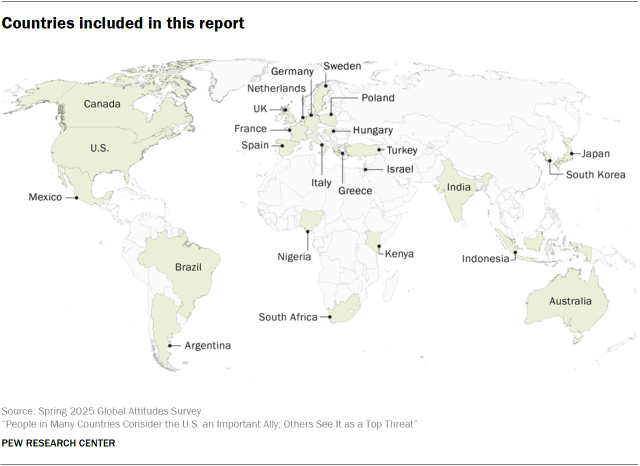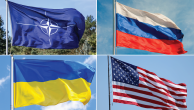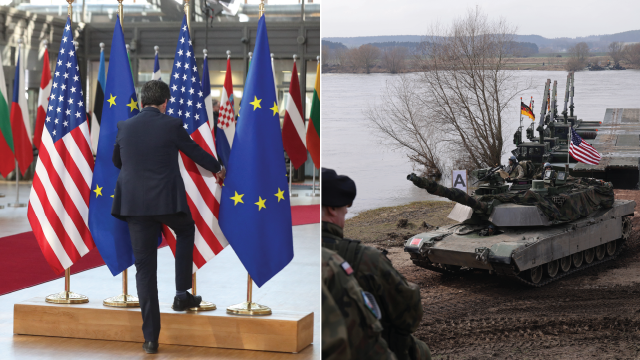
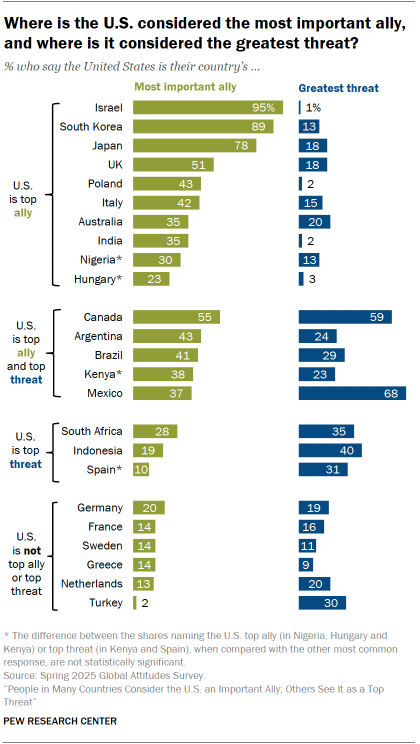
When asked which country is the most important ally to their own, many people around the world name the United States. This is the most common response in 12 of the 24 non-U.S. countries included in a new Pew Research Center survey. It is tied for the top response in three additional countries.
But others say the U.S. is their nation’s greatest threat. This is the most common response in six countries and tied for top in two others.
In neighboring Canada and Mexico, as well as in Argentina, Brazil and Kenya, the U.S. is the top response on both the ally and threat questions.
Respondents could name anything that came to mind for these questions. We did not ask them to choose from a list.
Russia and China also emerge as key threats
Russia is the most commonly named threat in eight of the 10 European countries surveyed. (It ties with the U.S. in one more: Spain.) In France, Germany, the Netherlands, Poland, Sweden and the United Kingdom, roughly half of adults or more say Russia is their country’s greatest threat.
In the U.S. and in several Asia-Pacific countries, people tend to see China as their greatest threat. It’s the most common response in Australia, Japan and the U.S., and the second-most common in India and South Korea. In Indonesia, China is tied with Israel for the second-most common response.
In general, proximity and historical conflict both seem to play an important role in which countries people see as significant threats to their own.
For this analysis, we surveyed 31,938 adults in 25 countries, including the U.S., from Jan. 8 to April 26, 2025. The survey was conducted prior to the start of the Israel-Iran war in June, and before the U.S. attack on Iran’s nuclear facilities. Refer to Appendix A for more details about the survey field period.
Views of the U.S.
As an ally
Israeli adults are especially likely to name the U.S. as their country’s most important ally. Israelis also stand out for their particularly positive ratings of the U.S. and its president, the same Center survey found.
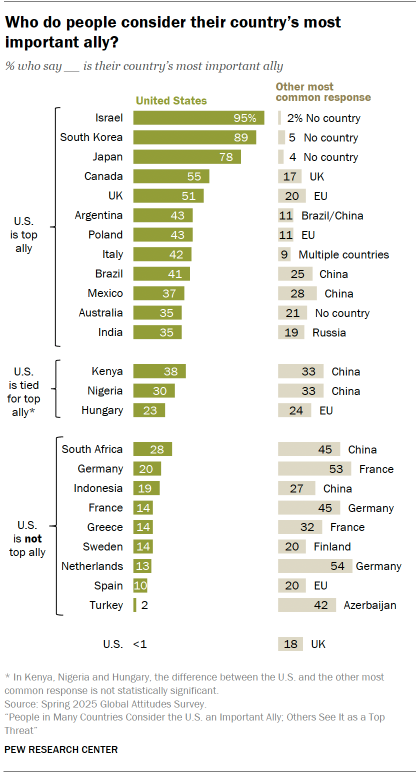
Japanese and South Koreans, too, overwhelmingly agree that the U.S. is their most important ally. Very few name any other country.
And roughly half of adults or more in Canada and the UK name the U.S. as their most important ally. For their part, 18% of Americans see the UK as their top ally (the most common response) while 12% name Canada (the second-most common).
Related: Americans’ views of allies and threats
Though fewer than half of people in Argentina, Australia, Brazil, India, Italy, Mexico and Poland name the U.S. as their most important ally, it is still the most common response in each of these nations. In Kenya, as well as in Nigeria, similar shares see the U.S. and China as top allies. And in Hungary, similar shares name the U.S. and the European Union.
In countries where the U.S. is not the most common response, there are a few others that tend to rise to the top:
- Germany is the most common response in France and the Netherlands.
- France is the most common response in Germany and Greece.
- In Indonesia and South Africa, more people name China than any other country.
Read more about views of allies in Chapter 1.
As a threat
Though the U.S. is seen as an important ally in many places, people in eight countries most frequently name it as their top threat. Majorities in both Canada and Mexico view the U.S. this way, as do roughly a quarter of adults or more in Argentina, Brazil, Indonesia and South Africa. In Kenya and Spain, the U.S. ties for the top response on this question.
In an additional 10 countries, including many in Europe, the U.S. is the second-most common response, or tied for second.
Views of the U.S. as a threat over time
We asked a version of this question in 2019, with slightly different – but comparable – wording. Since then, the share of Canadians naming the U.S. as their country’s greatest threat has almost tripled, from 20% to 59%. The share of Mexicans who say the same has shown a smaller but still significant increase, from 56% to 68%.
Notably, there are three countries where the share naming the U.S. as their top threat has dropped. This is the case in Turkey (where it fell from 46% in 2019 to 30% today), Argentina (from 40% to 24%) and Israel (from 4% to 1%).
In addition to the U.S., Russia and China have also emerged as key threats across the 25 countries surveyed.
Read more about views of threats and their perceived impact on economic and national security in Chapter 2.
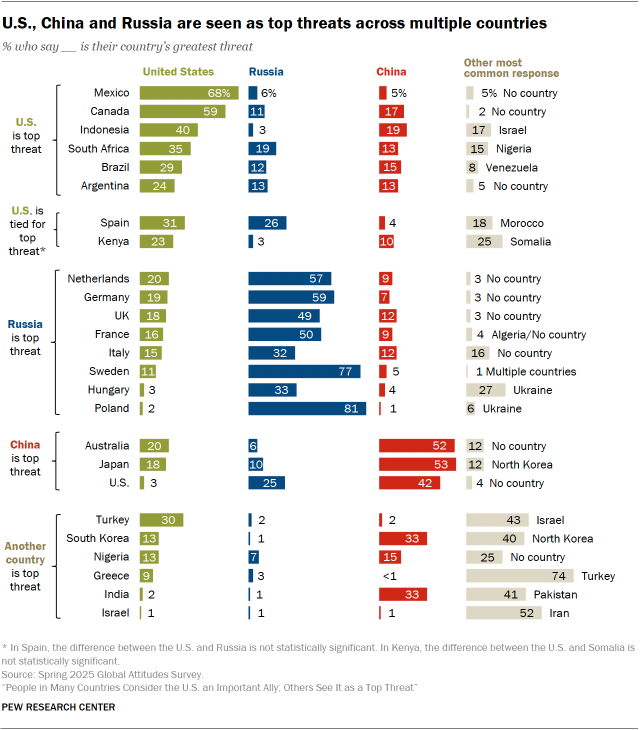
As both ally and threat
In Argentina, Brazil, Canada and Mexico – all located in the Americas – the U.S. is the most common response on both the ally and threat questions. About two-in-ten adults or more in Canada (25%) and Mexico (20%) see the U.S. as their country’s top ally and top threat. In Argentina and Brazil, only around one-in-ten name the U.S. on both questions.
In Kenya, similar shares name the U.S. and China as their most important ally, while the U.S. is tied with Somalia as the top threat.
Russia as a threat
Russia is the most commonly named threat in eight of the 10 European countries surveyed, with majorities in Germany, the Netherlands, Poland and Sweden taking this stance. In Spain, similar shares name the U.S. and Russia. Greece is somewhat of an outlier among the European countries surveyed: Only 3% name Russia as a top threat, and instead 74% say Turkey.
Supporters of right-wing populist parties in some European countries are less likely to see Russia as their top threat. This is true for supporters of Fidesz in Hungary (11% vs. 52% among nonsupporters), Alternative for Germany, or AfD (31% vs. 67%), Party for Freedom in the Netherlands (49% vs. 60%) and Lega in Italy (25% vs. 35%). But few among these groups, if any, see Russia as an ally. (Read Appendix B for more information on how we classify populist parties.)
Ukraine is the second-most commonly named threat in Hungary (27%) and tied for second in Poland (6%), both of which share a border with the country. Our research has also found that roughly three-quarters of Hungarians lack confidence in Ukrainian President Volodymyr Zelenskyy to do the right thing regarding world affairs, while views of him are mixed in Poland.
Fidesz supporters are particularly likely to view Ukraine as Hungary’s top threat (45% vs. 14% among nonsupporters). In fact, they are four times more likely to name Ukraine than to name Russia.
China as a threat
Many people in the U.S. and in the Asia-Pacific region believe China poses the greatest threat to their country. Roughly half of adults in Australia and Japan hold this view, as do a third in South Korea (ranked second behind North Korea, 40%) and India (after Pakistan, 41%). The India survey was conducted Feb. 7-April 21, 2025, before the recent deadly conflict between India and Pakistan.
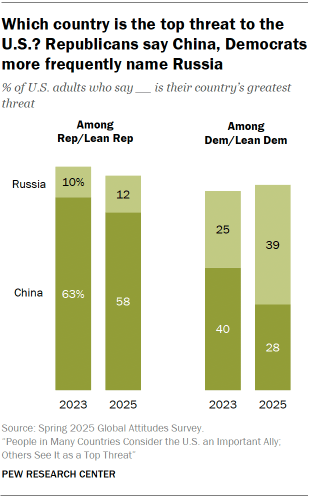
China is the top-ranked threat in the U.S. (named by 42% of Americans), though views differ by party. Republicans and Republican-leaning independents name China more than any other country (58%), while Russia is the top response among Democrats and Democratic leaners (39% vs. 28% who name China).
Views of China as a threat over time
When we last asked this question in the U.S. in 2023, China was seen as the top threat by both Republicans and Democrats. Views among Republicans have not changed much since then. But Democrats are now much less likely to name China – and much more likely to name Russia – as their country’s greatest threat.
The share of people in India who name China as their greatest threat is up 16 percentage points since 2019. In Canada, on the other hand, the share who point to China has fallen by 15 points over that period. China was the top-ranked threat in Canada before the U.S. took its place in the most recent survey.
Other top threats
Israel is the only country we surveyed in which almost no one views the U.S., Russia or China as a threat. Instead, 52% of Israelis name Iran as the top threat to their country, while 17% say Hamas. (Our questions asked about countries, but people were able to name another entity if they chose to.) The Israel survey was fielded Feb.5-March 11, 2025, during a recent ceasefire between Israel and Hamas and before Israel launched air strikes on Iranian nuclear facilities and other targets on June 13.
A majority of Israelis also named Iran as their greatest threat in 2019, when we asked a similar question.
People in Turkey name Israel as their country’s greatest threat (43%). This is a marked increase since 2019, when only 10% of Turks held this view. At that time, the U.S. was seen as the top threat.
In Indonesia, another Muslim-majority country, 17% of adults name Israel (tied with China for the second-most common response).
